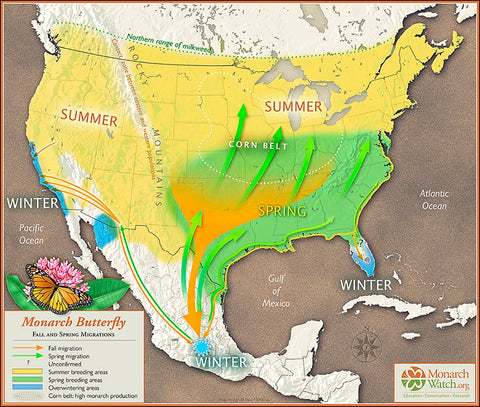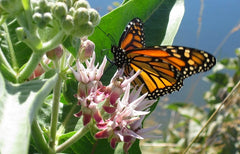The Monarch Butterfly
Known for one of nature’s great animal migrations, each spring and fall millions of Monarch butterflies migrate between their overwintering sites in Mexico and Coastal California, to breeding sites scattered across much of the United States and southern Canada. Their arrival in Canadian provinces is a welcome sign of the change in seasons from spring to summer. Although Monarch butterflies are not seen in large numbers on BC’s south coast, a small number of individuals have been documented on Vancouver Island. It is often occurrence for migrating Monarch individuals to be blown off-course by wind and weather patterns, hence making their appearance in our area during the summer.

There are two populations of Monarch butterflies in North America separated to the East and West of the Rocky Mountains. The main population resides in the east, travelling from Mexico through Texas and other southern states, breeding as they migrate north, ending their journey in the northern U.S. and southern Canada. Meanwhile western Monarchs migrate from their overwintering sites along the California coast moving inland and north towards southern British Columbia.
As recent as the early 1990’s the eastern Monarch population was estimated to be nearly 700 million making their epic journey across the northern plains of the U.S. and Canada to sites in the Oyamel fir forests just north of Mexico City. Meanwhile western Monarch populations were more than one million overwintering along the Californian coast. However, most recent estimates of Monarch populations show an over 80% decline in the east, and 74% in the west. With this, many researchers and scientists are worried that such dangerously low levels could lead Monarch populations to collapse.
Why Monarch Butterflies are at Risk
The reasons for declining Monarch populations can linked to a number of issues…
- Loss of milkweed, and breeding habitat needed for Monarch caterpillars to grow and develop. Due to large scale land conversion to agricultural monocultures of corn, wheat, and cattle, Monarchs have little to no habitat to forage and breed along their migration routes.
- Insecticide and herbicide use, used for agriculture and land management to control insects and weeds. This has unintended consequences for Monarchs who are especially susceptible to their use.
- Overwintering Habitat Loss, due to development in forested overwintering sites in California and illegal logging in the Oyamel fir forests of central Mexico.
- Prolonged drought, in California and other areas in the western U.S., resulting in lower milkweed biomass, and reduced availability in the summer.
The best way to help migrating Monarch butterflies is to plant milkweed!


